The Internet of Things refers to the use of information sensing devices such as RFID, infrared sensors, GPS, laser scanners, etc., to connect any item with the Internet according to the agreed protocol, and to exchange information and communicate to realize intelligent identification, positioning and tracking. A network that monitors and manages.
The Internet of Things has two main characteristics, namely, scale and real-time. First, the scale, only the scale, can make the intelligence of the item play a role. The second is real-time, through the sensing device embedded in or attached to the item or external information acquisition technology, the status of the item can be reflected every very short time, including static or sports, safe or dangerous, good or rotten, can be reflected in real time. Come out, such as airport perimeter, cultural relics monitoring, bridge monitoring, environmental monitoring, food traceability, etc.
IoT development stage and structureAccording to market development, the Internet of Things can be divided into four stages: concept, research and development, experiment and application. According to the application development, the development of the Internet of Things can be divided into islands, closed, limited objects and unlimited objects.
In the island stage, the Internet of Things is applied in a small area within a certain industry or field. The industry has not yet formed uniform standards and technical specifications. In the closed stage, Internet of Things applications in a certain industry or field have formed unified industry standards and technical specifications. In the limited material phase, cross-industry unified standards and technical specifications across a limited number of industries or areas of IoT applications; in the infinite IoT phase, including most industries or areas of IoT applications, adopting unified standards And technical specifications. The Internet of Things is divided into three layers in the architecture, namely the sensing layer, the transport layer and the application layer.
The perception layer is the basic physical network for the Internet of Things to perceive, identify and collect information in the real world. The main function is to identify objects and collect information, and provide massive and accurate data information support for subsequent information processing and corresponding decision-making behavior.
The transport layer is an important network cluster that realizes seamless connection and comprehensive coverage of the Internet of Things. It is responsible for the high-speed, low-loss, secure and reliable transmission of the data information of the sensing layer and the collected data to the application layer. Good resistance to external interference and illegal intrusion.
The application layer realizes the combination of IoT technology and application, and finally forms a collection of IoT applications involving people's daily learning, work and life aspects.
Developing the Internet of Things has become an important development strategy for countries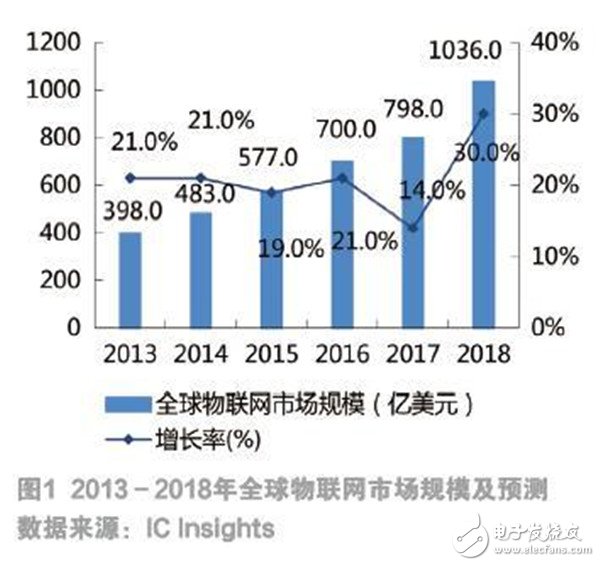
The global Internet of Things market is expanding and the number of connected devices is growing rapidly. It is estimated that by 2018, the global IoT market will exceed 100 billion US dollars, and the average annual growth rate of connected devices will remain above 31% (Figure 1 and Figure 2).
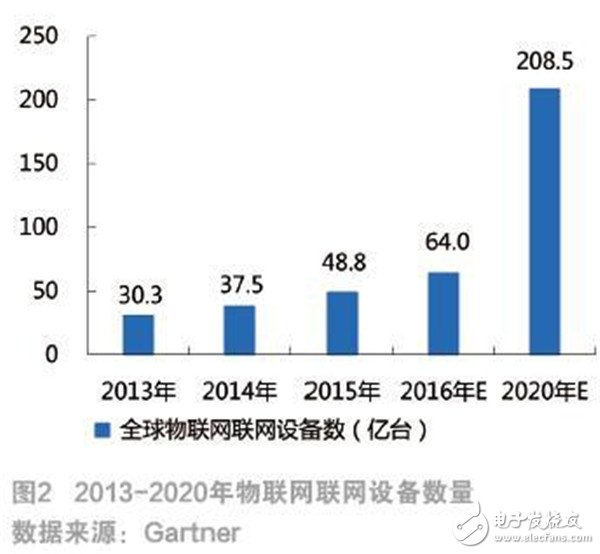
With the continuous development of the Internet of Things technology and the continuous expansion of the market scale, it has become an important strategy for technology and industrial innovation in countries around the world.
The United States put forward the concept of "smart planet", which triggered the global Internet of Things concern and raised the Internet of Things as one of the priorities of the national innovation strategy. Advanced hardware design and manufacturing technology, and the communication interconnection network that has been perfected have created favorable conditions for the development of the Internet of Things. At present, the United States has begun to accumulate Internet of Things applications in the fields of industry, agriculture, military, medical, environmental monitoring, construction, space and ocean exploration.
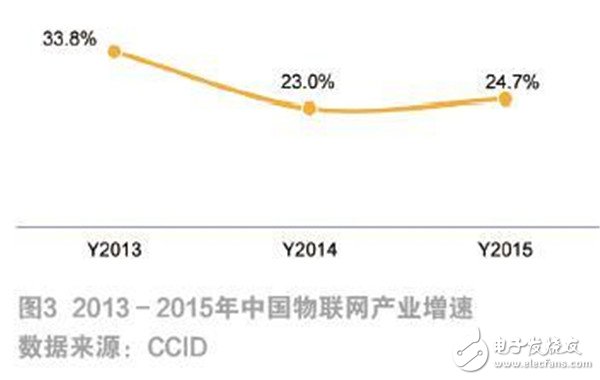
The European Commission issued the "Internet of Things - European Action Plan" and proposed 14 frameworks including chips and technology research and development. The EU has successively issued comprehensive report documents on technology research and development, index formulation, application areas, management monitoring, and future targets, and established a relatively complete IoT policy system. Especially in the application of intelligent transportation, the EU relies on the traditional advantages of its car companies to lead the research and application of the Internet of Vehicles through alliance cooperation.
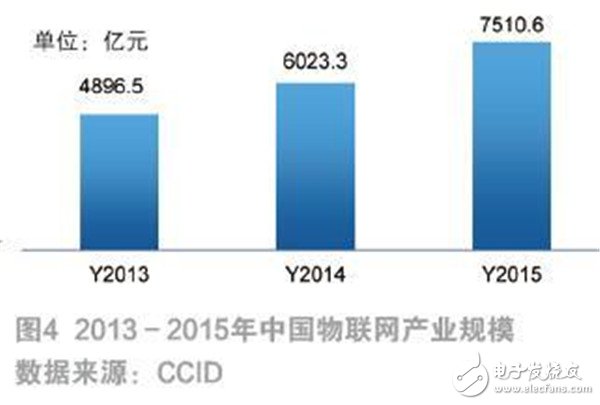
South Korea attaches great importance to the development of the Internet of Things, and continues to increase its research and development in the core technology of the Internet of Things and micro-electromechanical systems (MEMS) sensor chips and broadband sensing devices. At present, the Korean Internet of Things industry is mainly concentrated in Seoul, Gyeonggi Province and Daejeon, and Seoul has concentrated more than 60% of IoT companies across the country. The advantages of the Korean Internet of Things are its consumer smart terminals, RFID, NFC products and corresponding technology solutions.
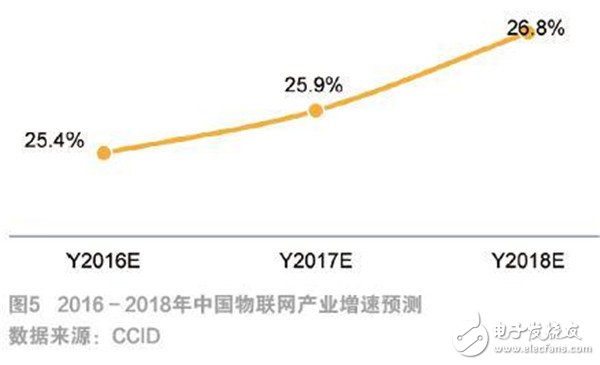
China has also made a number of national policies and plans for the development of the Internet of Things, and promoted the continuous improvement of the Internet of Things industry system. "Italian Network "Twelfth Five-Year" Development Plan", "Guiding Opinions on Promoting the Orderly and Healthy Development of the Internet of Things", "Ten Special Action Plans on the Development of the Internet of Things", and the recently issued "Made in China 2025" and many more The policy has been continuously introduced, and pointed out that “Mastering the key core technologies of the Internet of Things, basically forming a safe and controllable and internationally competitive Internet of Things industrial system, has become an important force to promote economic and social intelligence and sustainable development.†In the development of the Internet of Things Driven by the upsurge and related policies, China's Internet of Things industry will continue to maintain rapid growth. Although the growth rate has declined slightly in recent years, it still maintains a growth rate of over 23% (Figure 3). By 2015, China's Internet of Things The industrial scale has exceeded 750 billion yuan (Figure 4). It is expected that in the next few years, China's Internet of Things industry will show an accelerated growth trend (Figure 5). It is estimated that by 2020, China's Internet of Things industry will exceed 1.5 trillion yuan (Figure 6).

At the perception level, there are many and scattered enterprises, and the core technology of independent sensors is insufficient. The high-end sensor chips are mainly imported, and the market competition is fierce. The main applications are RFID tags and readers, various sensors, cameras, QR code tags and readers.
The development trend of sensory sensors:
(1) Miniaturization. The surge in information in the information age has led to an increasing demand for sensors to capture vast amounts of information.
(2) Intelligent. Requirement not only enables information processing and information storage, but also logical thinking and conclusion judgment.
(3) Multi-functionality. A variety of sensitive components are assembled on a material or on a separate chip.
(4) Wireless network. Sensors are required to collaboratively monitor, sense, and acquire information from various environments or monitored objects in real time through a variety of integrated miniature sensors. Thereby realizing the concept of "ubiquitous computing".
At the transport layer, the transmission is mainly based on the mobile communication network and the local area network, and the Internet is still less used. The industrial development is relatively complete, and the enterprises are mainly traditional communication enterprises. The main equipments of the transmission layer include optical fiber optic cable, optical components, optical access equipment, optical transmission equipment and other optical transmission equipment, as well as 3G/4G/5G, NFC, ZigBee, Bluetooth, Wifi/WAPI and other communication and network equipment.

The main function of the transport layer is to transmit the perceived layer and collected data information to the platform layer at a high rate, low loss, and securely and reliably. At present, the degree of standardization is relatively high, the industrialization ability is strong, mature, and there are many participating manufacturers, which has become a fierce competition in the industry. After the large-scale deployment of LPWA, the number of Internet of Things connections will increase rapidly, and the technology represented by NB-IoT solves the obstacles to the popularity of mobile Internet of Things. In the future, 5G will meet the diversified needs of advanced applications of the Internet of Things to achieve the ultimate Internet of Everything.
The application layer is mainly software and modern service enterprises. The basic software technology is mainly in the hands of multinational enterprises. Traditional IT enterprises are gradually involved in the Internet of Things business. As the demonstration applications of Internet of Things increase, the number of enterprises will increase significantly.
With the maturity of the Internet of Things technology and the development of the industry, the fields involved are becoming more and more extensive, and currently concentrated in nine fields.
IoT applications cover a wide range of individuals, families and businesses, and there is huge room for growth. The smart home field has received extensive attention due to its high level of integration with daily life, and has become a rapidly growing application area. The demand for intelligent transportation and smart medical fields is broad and the added value of products is high. Among them, the car network has quietly become a pioneer in the development of the Internet of Things.
The development of Internet of Things applicationsChina's current industrial, medical, transportation, financial, security and other aspects of the Internet of Things applications have been correspondingly developed. Taking intelligent transportation as an example, although the intelligent transportation industry is still in its infancy in China, ITS has been highly valued by relevant state departments as a new economic growth point and an inevitable choice for transportation system construction. In 2015, the overall market size of intelligent transportation reached 69.13 billion yuan, a year-on-year increase of 30.5%. With the proposal of the “Notice on Further Accelerating the Construction of Urban Public Transport Intelligent Application Demonstration Project Constructionâ€, the demonstration project construction tasks of 37 demonstration cities will be completed by the end of June 2017. Greatly promote the development of intelligent transportation.
Regarding the development of the Internet of Things, Vice Chairman Chen Xian of the China Semiconductor Industry Association put forward the following suggestions: actively construct the ecological environment for the development of the Internet of Things and sensors; promote the application of public infrastructure and service systems with smart city construction; increase research and development efforts, Improve the collaborative innovation system; focus on breakthroughs, accelerate the entry into the high-end sensor market; promote mature application models, foster new business models; accelerate the establishment and implementation of information security systems.
Magnetoelectric Proximity Switch
The magnetic proximity switch is a kind of proximity switch. The magnetic proximity switch is one of many types in the sensor family. It is made by the use of electromagnetic working principle and advanced technology. It is a position sensor. It can transform the non-electricity or electromagnetic quantity into the desired electric signal through the change of the positional relationship between the sensor and the object, so as to achieve the purpose of control or measurement.
Motion Sensor Control Switch,Photoelectric Switch Sensors,Plug In Photoelectric Switch,Magnetoelectric Proximity Switches
Changchun Guangxing Sensing Technology Co.LTD , https://www.gx-encoder.com